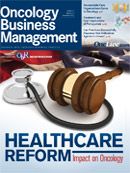Developing Patient-Centered Medical Homes
Medical homes are physician-led healthcare teams that coordinate care for patients and typically rely on electronic methods for record-keeping, care coordination, and data collection.
John Sprandio, MD
In a future-focused venture, ION Solutions, a physician services organization, has teamed up with John Sprandio, MD, president of the pioneering Consultants in Medical Oncology & Hematology, to assist oncology practices that are interested in becoming patient-centered medical homes.
Medical homes are physician-led healthcare teams that coordinate care for patients among various providers. Team members, including nurses and nurse practitioners, among other staff, reach out to patients to schedule preventive services and to follow up on potential health concerns, and are often available after hours, whether in person or electronically. Medical homes typically rely on electronic methods for record-keeping, care coordination, and data collection, as do accountable care organizations.
A growing number of community oncologists are looking to the model as a means to streamline services, improve care, and retain their independence in the face of financial pressures that are driving many solo practitioners to join larger organizations, such as hospitals.
Two years ago, Sprandio’s Pennsylvania-based medical oncology practice was the first in the country to earn Level III recognition from the National Committee for Quality Assurance (NCQA) under its Physician Practice Connections— Patient-Centered Medical Home (PCMH) Program.
“One goal in 2012 is to expand and verify the model,” said Sprandio, whose consulting company, Oncology Management Services, recently submitted its oncology adaptation of the PCMH criteria to the NCQA for consideration.
His company developed, among other tools, new physician data presentation and clinical decision support software (IRIS), as well as patient services such as a telephone triage and symptom management system to facilitate patient access to care. In becoming a medical home, he said his practice not only re-engineered its care processes, but continuously critiqued its performance by reviewing the data and making further improvements to standardize delivery and ensure that the services physicians were providing were efficient and clinically relevant.
Sprandio noted that patients also played a critical role in the process by monitoring and reporting symptoms so the practice could respond, thus avoiding hospital admissions and treatment of complications down the road. To help them, practices interested in moving toward the medical home model will need to make same-day appointments available, as well as provide access to the team after hours. “We tell patients to call early and often. If they’re experiencing symptoms at 8:00, call at 8:15. Patient engagement is a big component of this model.”
By implementing these measures, Sprandio’s practice has seen a reduction of a nearly 70% in emergency room use and a decline of just over 50% in hospital admissions for patients on chemotherapy, among other improvements, he said, adding, “Instead of restricting care, or shifting more of the cost burden on patients, we should focus on guiding the process of reducing waste.”
Mark Johnson
The new team’s quality management program is based on Sprandio’s experience in implementing national evidence-based guidelines, advance care planning for end-of-life care, and nurse triage systems, among other measures, said Mark Johnson, ION Solution’s president. They will also work with practices looking to integrate practice management systems—including electronic medical records (EMRs), inventory management cabinets, and claims management tools—to achieve greater connectivity among their technologies, improve their finances, and generate what Johnson calls “more meaningful and actionable data.”
“It has taken John years to change the methodology and amend systems accordingly, and we’ve contracted with him to take the lessons learned and make them available to other practices,” Johnson said, adding that ION Solutions will assist in bringing “the necessary assessment tools” to community oncology practices that are interested in becoming medical home‒certified or adopting medical home components.
The partnership with ION Solutions, which provides contract purchasing representation and operational support services to more than 1600 community oncology practices, gives Sprandio’s consulting firm the opportunity to extend the reach of its services throughout the country.
Sprandio said he hopes to begin working with six practices in Pennsylvania that are “committed to transforming to an [oncology PCMH] model of cancer care delivery.” The team will also work with practices to develop financial compensation models that reward them for eliminating wasteful services and providing better care, Johnson said.
“One of the goals is to provide a mechanism for practices to demonstrate improved results and to participate in the savings reaped from cost avoidance. Before the practice goes to the expense of implementing these processes, however, we want to make sure that payers will compensate them for the reductions,” Johnson explained. He said that ION Solutions can provide the infrastructure to implement clinical pathways and the analytics on performance to report back to payers.
According to Johnson, ION Solutions will help link practices in several ways to help them achieve benefits of scale, including developing clinically integrated networks in which providers maintain their independence, while collaborating on clinical initiatives and payer negotiations.
“The idea is that practices would align among themselves rather than to become part of some larger sort of organization. Our mission is to support care in the community and provide physicians with the resources they need to thrive,” he said, adding, “I see a renewed initiative by practices and payers to keep community- based practices viable.”
The Community Oncology Alliance has embraced the medical home model, calling it “the future for oncology.” The group has put together a steering committee, composed of patients, payers, and providers, to advance its implementation.
“These discussions are designed to help practices be a part of the solution with payers and patients, and to adopt change rather than have it dictated to them,” Johnson said. “We have a sense of urgency in working with physician support groups. Everyone plays an important role in this."




